







Diving German WW1 minelaying submarine UC-42.
Sidescan sonar image of Wreck of 1692 (to be confirmed) discovered by Carroll O'Donoghue, owner/operator of HARPY, in 2015.
A selection of our underwater survey hardware. We're ready when you need us.
Wreck-diving off the Old Head of Kinsale
Commercial Divers working on undersea pipes outside Kinsale harbour.
Recovering Diver after ascent from Lusitania wreck.
Sunset in Kinsale, pictured from the quays.
Coincidentally to the finding of UC-42 I was working in Heksinki, Finland where a very similar WW1 era submarine survives. She is the "Vesikko", a German type IIa submarine that was built in Turku, Finland for Germany. From these photos you may get a better feeling of what it was like aboard these submarines. Apologies for the poor quality of some of these photos when poor light compounded my own limitations.
Note that the Vesikko carries torpedoes in the forward section. The UC-42 on the other hand carried 6 mine tubes in the forward section, so you will need to imagine what the exact differences might have been. If anyone has plans of the UC-class minelayers I would love a copy!
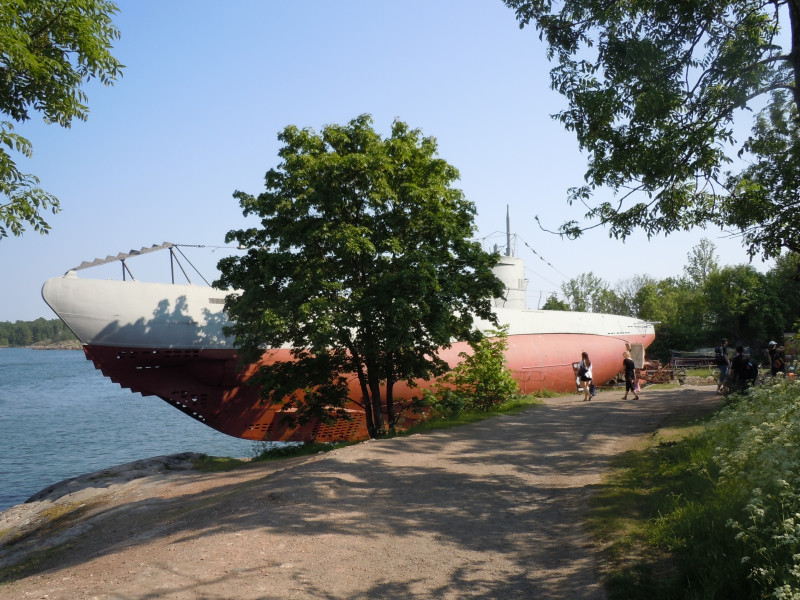
Looking forward at the 3 torpedo tubes of the submarine.
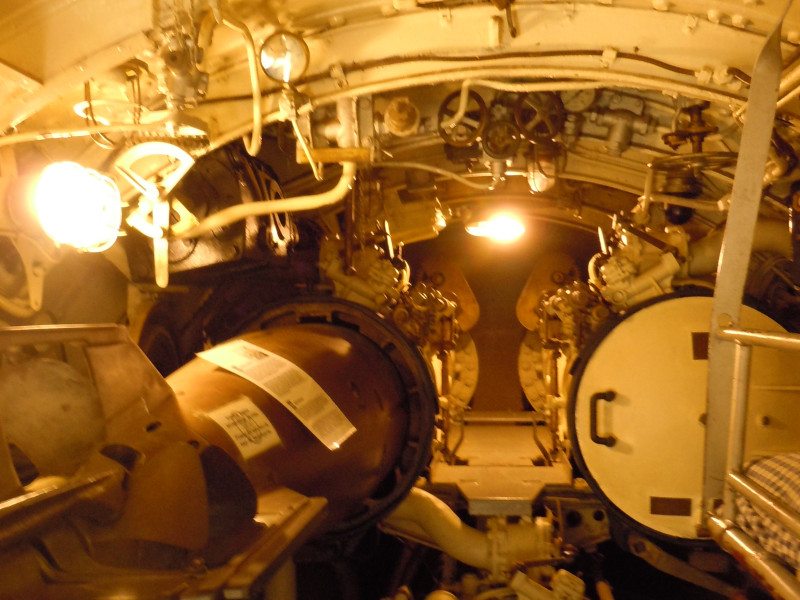
A hopefully clearer view of the torpedo in port tube. The tubes extented beyond the pressure case, being also supported by the outer hull.
The green hatch, top, is the torpedo loading hatch. Torpedoes were loaded from the bow, through this hatch aft and then dragged forward again into their holds in the torpedo room.
Visible here is the 3 tube firing panel. Not visible is the large mechanism to keep the loading hatch closed (which also acted as a torsion bar adding tension).
The 2 coarse pitched, contra-rotating propellors are very tightly packed into the torpedo for maximum effeciency.
Detail of the stbd. torpedo tube.
You are approximately below the conning tower, the ladder to which can be seen. The periscope is also visible. Behind is the engine room with it's 2 x 900BHP KVM diesel engines.
The maze of piping and valves mostly collect at the control room here. To the right, outside view is the sonar operator's seat.
With the engine telegraphs an also be seen an inclinometer, hyrdoplane controls and compass.
The green hatch leads onto the deck of the conning tower. The brass periscope tube can also be seen. There is also a hatch-cover (not visible) between the pressure hull and the conning tower.
Below the surface the U-boat is driven by electric motors using electricity drawn from the giant internal batteries. When these are depleted, they must be recharged. This is done by traveling on the surface under diesel engine power. The diesel engines are used to turn the electric motors so that they act as dynamos (generators) to recharge the depleted batteries. For rapid recharge, both diesel engines would be clutched onto the electric motors. For maximum range, one diesel engine would be clutched to an electric motor – which in turn acted as a generator to drive the other electric motor. Both propellers were turning in this way with only one diesel engine running.
Looking aft towards electric motors and clutches.
he compressor to refill the compressed air tanks needed for the blowing of the ballast at surfacing time. The refilling is done on the surface at the same time as the batteries are being charged. There was only 1 compressor aboard.
The navy term "hot bunks" refers to bunks that are in constant use - used by crew in shifts.
This forging is the control horn at the rear inside of the pressure hull which activates the linkage aft and outside to the top of the rudder stock.
All U-boat propellors are uniquely stamped with codes for the submarine they are intended to go onto. So, you can idientify a U-boat wreck from these propellor codes.
Looking forward at the 3 torpedo tubes of the submarine.
A hopefully clearer view of the torpedo in port tube. The tubes extented beyond the pressure case, being also supported by the outer hull.
The green hatch, top, is the torpedo loading hatch. Torpedoes were loaded from the bow, through this hatch aft and then dragged forward again into their holds in the torpedo room.
Visible here is the 3 tube firing panel. Not visible is the large mechanism to keep the loading hatch closed (which also acted as a torsion bar adding tension).
The 2 coarse pitched, contra-rotating propellors are very tightly packed into the torpedo for maximum effeciency.
Detail of the stbd. torpedo tube.
You are approximately below the conning tower, the ladder to which can be seen. The periscope is also visible. Behind is the engine room with it's 2 x 900BHP KVM diesel engines.
The maze of piping and valves mostly collect at the control room here. To the right, outside view is the sonar operator's seat.
With the engine telegraphs an also be seen an inclinometer, hyrdoplane controls and compass.
The green hatch leads onto the deck of the conning tower. The brass periscope tube can also be seen. There is also a hatch-cover (not visible) between the pressure hull and the conning tower.
Below the surface the U-boat is driven by electric motors using electricity drawn from the giant internal batteries. When these are depleted, they must be recharged. This is done by traveling on the surface under diesel engine power. The diesel engines are used to turn the electric motors so that they act as dynamos (generators) to recharge the depleted batteries. For rapid recharge, both diesel engines would be clutched onto the electric motors. For maximum range, one diesel engine would be clutched to an electric motor – which in turn acted as a generator to drive the other electric motor. Both propellers were turning in this way with only one diesel engine running.
Looking aft towards electric motors and clutches.
he compressor to refill the compressed air tanks needed for the blowing of the ballast at surfacing time. The refilling is done on the surface at the same time as the batteries are being charged. There was only 1 compressor aboard.
The navy term "hot bunks" refers to bunks that are in constant use - used by crew in shifts.
This forging is the control horn at the rear inside of the pressure hull which activates the linkage aft and outside to the top of the rudder stock.
All U-boat propellors are uniquely stamped with codes for the submarine they are intended to go onto. So, you can idientify a U-boat wreck from these propellor codes.
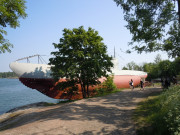
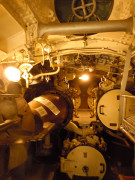
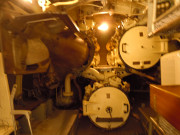
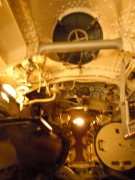
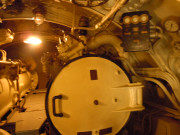
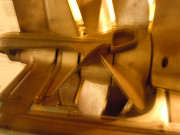
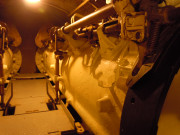
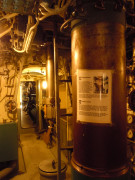

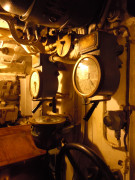
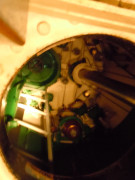

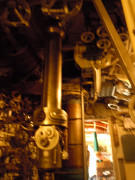
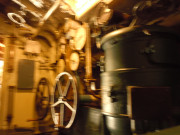
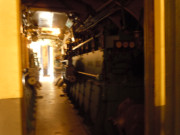
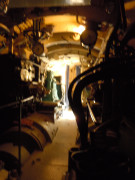
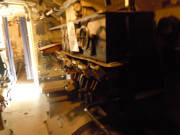

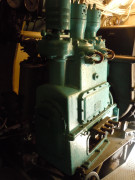
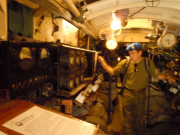
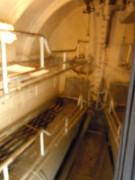
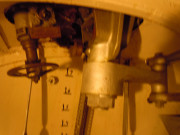

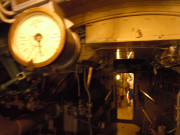
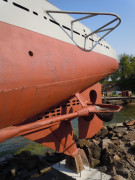
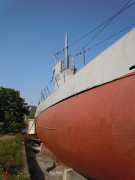
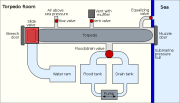
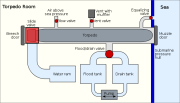
|
|
|
|